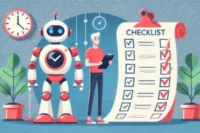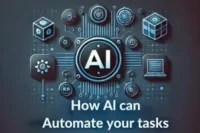How AI Tools Work – Step by step guide for you
Published: 02 Feb 2025
What Are AI Tools?
AI tools are software that perform human-like tasks, such as problem-solving, learning, and decision-making. Examples include chatbots, AI writing assistants, and automation tools.
Why Understanding AI Is Important?
AI is changing industries like healthcare, finance, and marketing. Knowing how AI works helps businesses and individuals save time, boost productivity, and stay competitive.
In this guide, you’ll learn How AI Tools work in details! 🚀
2. Overview: How AI Tools Work in Simple Terms
AI tools work like the human brain—they learn from data, recognize patterns, and make smart decisions.
How AI Tools Process Information
AI follows a step-by-step process:
- Data Collection: – AI gathers information from various sources.
- Training: The tool learns by analyzing past data.
- Evaluation: It tests its learning to improve accuracy.
- Deployment: The AI tool is used in real-world tasks.
Types of AI That Power These Tools
- Machine Learning (ML): AI learns from data to make predictions, like recommendation systems.
- Deep Learning: Advanced AI that mimics the human brain, used in image and speech recognition.
- Natural Language Processing (NLP): AI that understands and processes human language, like ChatGPT and chatbots.
AI tools, such as ChatGPT, image generators, and predictive models, use these techniques to automate tasks and improve efficiency.
3. Step-by-Step Process: How AI Tools Work
Step 1: Data Collection and Processing
- Data Gathering: AI tools begin by collecting data from various sources, such as text, images, videos, and sensors. This data serves as the foundation for training the AI model.
- Data Cleaning and Structuring: The collected data is cleaned to remove errors and inconsistencies. It is then structured in a way that makes it usable for analysis. This step ensures that the AI model learns from accurate and relevant information.
Step 2: AI Model Training
- Learning from Data: AI models are trained using machine learning algorithms that analyze the data to identify patterns and relationships. This training enables the AI to make informed decisions or predictions based on the data it has learned from.
- Types of Learning Methods:
- Supervised Learning: The AI learns from labeled data, where the correct output is provided for each input. This method is commonly used for tasks like image classification.
- Unsupervised Learning: The AI identifies hidden patterns in data without labeled outputs. This approach is useful for clustering similar items together.
- Reinforcement Learning: The AI learns by trial and error, receiving feedback from its actions. This method is often used in robotics and self-driving cars.
Step 3: AI Model Testing and Optimization
- Testing for Accuracy: After training, the AI model is tested using new, unseen data to evaluate its performance. This step helps determine how well the model generalizes to new situations.
- Optimization: If the model’s performance is not satisfactory, developers adjust and retrain it to improve accuracy. This iterative process continues until the model meets the desired standards.
Step 4: AI Model Deployment
- Real-World Application: Once optimized, the AI model is deployed into real-world applications. Examples include:
- Chatbots: AI models like ChatGPT are used in chatbots to answer user queries, providing instant customer support.
- Image Generation Tools: AI-powered tools assist graphic designers in creating art by generating images based on textual descriptions.
- Recommendation Systems: Platforms like Netflix and Amazon use AI to suggest content or products to users based on their preferences and behavior.
Step 5: Continuous Learning and Improvement
- Ongoing Learning: AI tools continue to learn from new data, allowing them to adapt to changes and improve over time. This continuous learning process ensures that the AI remains effective and relevant.
- Automatic Updates: AI systems are designed to update automatically, enhancing their accuracy and efficiency without manual intervention. This feature is crucial for maintaining the performance of AI applications in dynamic environments.
By following these steps, AI tools can effectively perform complex tasks, automate processes, and provide valuable insights across various industries.
4. Real-World Applications of AI Tools
- Chatbots & Virtual Assistants – AI tools like ChatGPT, Siri, and Alexa assist users by processing natural language.
- Image & Video AI – Tools like MidJourney and Runway generate and edit images/videos.
- AI in Business – AI helps in marketing automation, customer support, and fraud detection.
- Healthcare AI: AI is used for disease prediction, drug discovery, and medical image analysis.
AI tools improve efficiency and decision-making across industries.
Faqs:
AI tools are software programs that use artificial intelligence to perform tasks automatically. They analyze data, recognize patterns, and make decisions. Examples include chatbots, AI writing assistants, and image generators.
AI detection tools scan and analyze data to find patterns, errors, or unusual activities. For example, AI plagiarism checkers compare text with online content, and fraud detection AI spots suspicious transactions. They improve over time by learning from data.
AI software follows programmed rules and learns from data to complete tasks. It uses machine learning (learning from past data) and natural language processing (understanding human speech) to make decisions. Examples include voice assistants like Siri and AI-powered analytics tools.
AI apps use artificial intelligence to help users with specific tasks like writing, designing, or analyzing data. They process information, apply AI models, and provide smart suggestions or automate actions. Examples include AI chatbots, AI-powered photo editors, and recommendation apps.
AI processes large amounts of data using algorithms that help it learn, make decisions, or predict outcomes. It uses machine learning (learning from patterns) and deep learning (mimicking human brain functions). AI doesn’t think like humans—it follows data and logic.
John McCarthy is known as the “Father of AI.” He introduced the term “Artificial Intelligence” in 1956 and developed Lisp, a programming language used in AI research. His work laid the foundation for modern AI advancements.
Conclusion
So guys, in this article, we’ve covered How AI Tools Work in detail. Now, it’s time to take action! AI isn’t just a trend—it’s a powerful tool that can help you save time, work smarter, and unlock new opportunities. I recommend starting with a simple AI tool, like a chatbot or an AI-powered design assistant, to see the impact firsthand. Ready to make AI work for you? Explore different tools, experiment with their features, and take advantage of AI’s potential. The future is AI—don’t get left behind!

- Be Respectful
- Stay Relevant
- Stay Positive
- True Feedback
- Encourage Discussion
- Avoid Spamming
- No Fake News
- Don't Copy-Paste
- No Personal Attacks

- Be Respectful
- Stay Relevant
- Stay Positive
- True Feedback
- Encourage Discussion
- Avoid Spamming
- No Fake News
- Don't Copy-Paste
- No Personal Attacks






